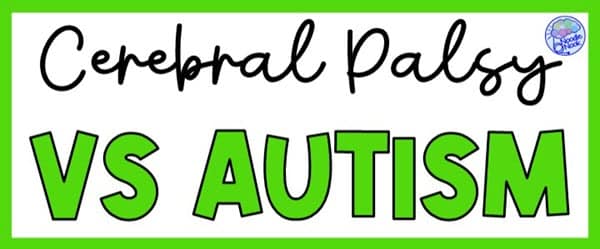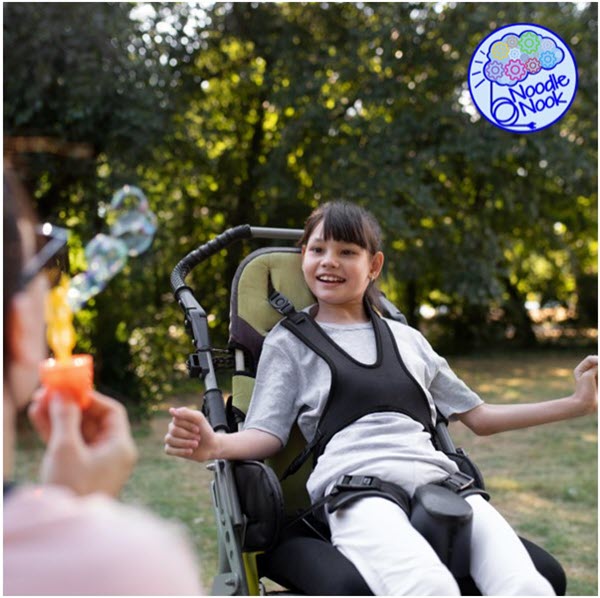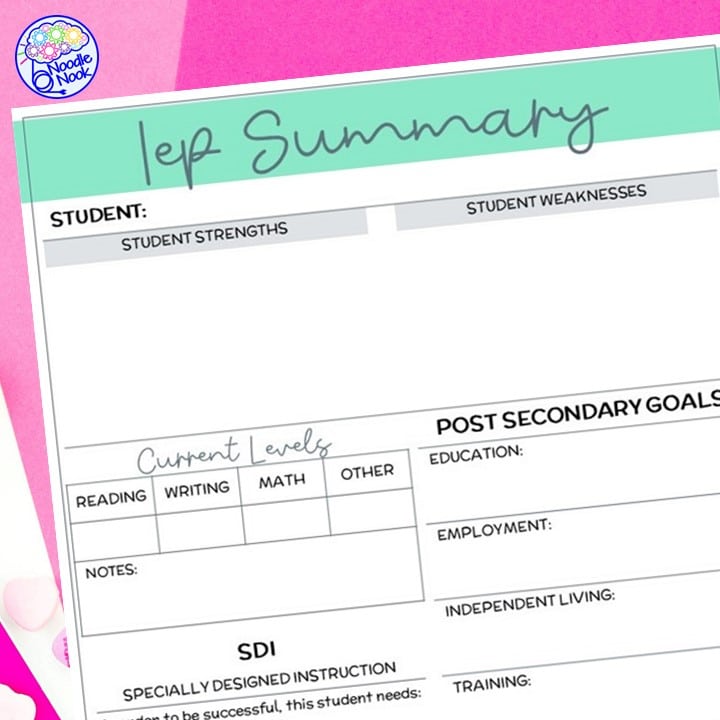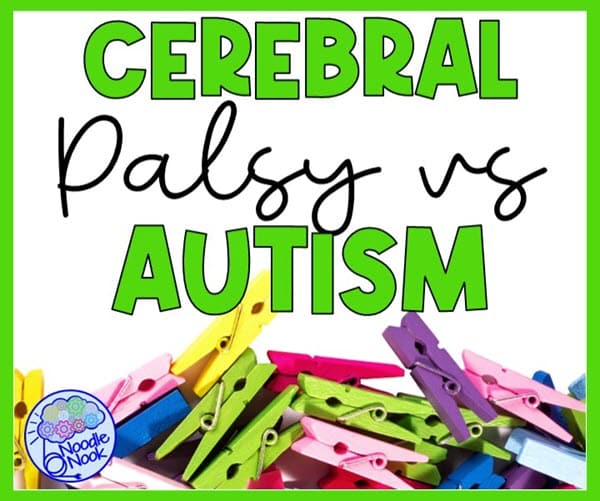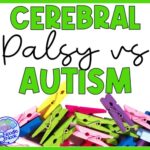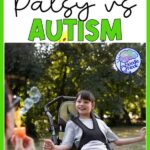Let’s face it… as a special education teacher, you never know what types of students will end up in your classroom. Disabilities and abilities will vary greatly from year to year and student to student. Understanding the differences between them can be the key to providing effective support and creating a positive and inclusive classroom. In this post, we’ll explore the key differences in cerebral palsy vs autism in detail. Then we’ll give you some specific strategies and ideas that will help you better support your students. Let’s dive in and help you to transform your classroom and instruction!
What Is Cerebral Palsy vs Autism
As we dive into this topic, it’s good to make sure we all understand the basics. Cerebral palsy and autism spectrum disorder (ASD) are both neurodevelopmental disorders but affect different areas of a child’s life. Autism primarily impacts social interactions and communication skills, while cerebral palsy is characterized by motor disabilities due to brain damage. Let’s take a closer look at each.
Cerebral Palsy (CP)
Cerebral palsy is a condition that affects movement and posture. It happens when there’s damage to the developing brain, which can occur before, during, or shortly after birth. As a result, kids with cerebral palsy may have trouble controlling their muscles, which can make it challenging for them to do things like walking or picking up objects. However, cerebral palsy doesn’t impact a child’s intelligence or ability to learn.
Autism Spectrum Disorder (ASD)
Autism spectrum disorder, or ASD, is all about social and communication skills. Kids with autism might find it tricky to understand or express feelings, and they could have difficulties making friends or engaging in conversations. Some children with autism might also engage in repetitive behaviors or have specific interests. ASD is a spectrum, which means that it can affect kids in different ways, from mild to more severe.
What is the Difference Between Cerebral Palsy vs Autism
Several key differences make cerebral palsy and autism so unalike. It’s important to first acknowledge that if you are trying to determine if a child has either disability, you consult a medical professional for diagnosis.
- Social Skills:
One of the major differences between cerebral palsy and autism is the aspect of social skills. Autistic children often face challenges in social-communication development, making it harder for them to interact with others.
- Motor Functioning:
On the other hand, cerebral palsy affects muscle control and tone, leading to difficulties in motor functioning.
- Risk Factors and Causes:
Autism’s exact causes are still unknown, but research points towards a combination of genetic and environmental factors. On the other hand, cerebral palsy is often a result of brain damage, which can occur before, during, or shortly after birth. Some risk factors for cerebral palsy include preterm birth, birth injuries, and preventable medical errors.
- Early Intervention and Treatment Options:
Early intervention is vital for both cerebral palsy and autism. Those therapies, however, differ. For autism, interventions like speech therapy, occupational therapy, and applied behavior analysis can significantly improve a child’s ability to socialize and communicate. In contrast, physical therapy and developmental medicine are commonly used to help children with cerebral palsy improve their motor skills.
- Prevalence and Genetic Factors:
Autism affects a broad range of conditions, with specific genetic variants playing a role in its development. In contrast, cerebral palsy is the most common motor disability in childhood and is not attributed to a single genetic factor. Understanding the prevalence of these disorders can help teachers cater to their student’s individual needs better.
- Diagnosis and Medical Support:
Diagnosing autism involves observing a child’s behavior and development, along with clinical evaluations, while cerebral palsy is often identified through physical assessments and medical tests like blood tests and brain imaging. In both cases, a multidisciplinary team, including medical professionals, social workers, and therapists, plays a crucial role in the diagnosis and treatment process.
- Cognitive Abilities:
The intellect of individuals with these two disabilities can be vastly different. In cerebral palsy, intellectual abilities can vary widely, and some children may have learning disabilities, while others may have average or above-average intelligence. With autism, cognitive abilities also vary greatly and IQ can be difficult to assess. There is a higher prevalence of intellectual disability in autism compared to the general population.
Known Cure and Goal of Treatment
This article focuses in on differences in cerebral palsy vs autism, but there is one commonality between them. Currently, there is no known cure for autism or cerebral palsy. With that said, early interventions and appropriate therapies can significantly improve the child’s quality of life and maximize the potential for children with both diagnoses. The goal of treatment for both disorders is to enhance the child’s social functioning, communication, and overall development.
What This Means in the Classroom:
As teachers working with students who have significant disabilities, understanding the differences between cerebral palsy and autism can help you do what you do, but better. That means providing more effective support plus creating a positive and inclusive classroom. To make that easier for you, here are some actionable steps and ideas to implement in your classroom:
- Understand the Individualized Education Plans (IEPs):
If you are working with students who have a diagnosed disability that qualifies them for special ed services, it means they have an IEP. You’ll collaborate with parents, therapists, and specialists to create comprehensive IEPs that are tailored to each student’s specific needs. As you are setting up your classroom, be sure you read through that legally binding document. Focus on setting goals related to social skills, communication, motor functioning, and academic progress.
- Use Differentiated Instruction:
Remember, every student is unique and learns in their own special way. That’s why differentiated instruction is your secret weapon! It means tailoring your teaching methods to match each student’s needs and abilities. Get creative with your lessons and use various tools and approaches to reach all your kids, no matter their challenges. You may include manipulatives for students with autism to grasp concepts and ideas. It may also include adaptive tools and assistive technology for students with cerebral palsy to do the same.
- Promote Inclusive Social Activities:
Let’s make the classroom a fun and friendly place for everyone! Encourage social interactions and teamwork among your students. Plan activities that bring kids together, regardless of their abilities, and watch the magic of inclusivity unfold. You will have to do some explicit instruction with students to help them navigate social nuances. Build in social stories and role-playing into your classroom (Learn More)!
- Include Communication Support:
Students with autism may have difficulty with verbal communication. Students with cerebral palsy may have difficulty with articulation. Both students need our help, so let’s find ways for them to express themselves while developing those skills. Use pictures, symbols, or assistive devices to help all your students communicate and be heard in the classroom.
- Set Up for Motor Skills Support:
Students with cerebral palsy might need some extra help with their motor skills. Arrange your classroom to accommodate their needs, providing assistive tools or special seating arrangements to make moving around easier. Consider physical needs as well as sensory needs to set up the right motor supports for all your students.
- Create a Sensory-Friendly Environment:
Some kids with autism can get overwhelmed by sensory stimuli. Create a calm and comfortable classroom environment by minimizing noise and distractions. Use visual cues and schedules to keep things predictable and reduce anxiety. Students with cerebral palsy, as well as all students with disabilities, benefit from a balanced sensory day. This tip can support all your students.
- Implement Visual Schedules:
Visual schedules are a lifesaver for many students with autism. They offer a clear roadmap of the day’s activities, making transitions smoother and less stressful. For students with cerebral palsy, having a schedule to reference to get them where they need to be on time is an added perk. This is especially true if a student needs extra time or support to transition. Give visual schedules a try, and you’ll see the positive impact it can have! Check out the one from Noodle Nook!
- Encourage Peer Support:
Teaching empathy and understanding is key! Foster a culture where all your students support and help one another. Encourage peer friendships and cooperation to build a strong, inclusive community in your class. Every student will benefit from peer interactions and a positive learning environment.
- Engage in Professional Development:
Learning never stops, right? Stay updated on the latest strategies and best practices for teaching students with disabilities. Attend workshops, webinars, and training sessions to level up your teaching skills. If you are interested in having me out to teach your team in person or to take an online class, click here!
Remember, every child is unique, and the strategies that work for one student may not work for another. Flexibility, patience, and a willingness to adapt your teaching methods are essential when supporting students with cerebral palsy and autism. It can take a little bit of trial and error and a whole lot of adjustments, but you can do this!
RECAP: Cerebral Palsy vs Autism
Cerebral palsy and autism are distinct neurological disorders that affect children in different ways. Understanding the major differences between them, along with their prevalence and underlying causes, can help teachers and caregivers provide better support and care for their students. Early intervention, a multidisciplinary approach, and tailored treatment plans are essential in helping children with cerebral palsy and autism find success in and out of school. Stay informed, and continue learning about the latest research and studies in the field from reputable sources like the Mayo Clinic, the Child Neurology Journal, and the Robinson Research Institute. Together, we can make a positive impact on the lives of numerous children with developmental disabilities.
FAQ: Cerebral Palsy vs Autism
There are a few questions that seem to pop up all the time when I talk about cerebral palsy vs autism. Here is a collection of a few that can help you navigate teaching students with either of these disabilities.
What is the difference between Cerebral Palsy and Autism?
Cerebral Palsy (CP) is a condition characterized by motor disabilities caused by brain damage. It affects movement and posture, leading to challenges in controlling muscles. On the other hand, Autism Spectrum Disorder (ASD) primarily impacts social interactions and communication skills, and it is a neurodevelopmental disorder without a direct impact on motor functions.
What are the early signs and symptoms of Autism?
Early signs of Autism include difficulties in social interactions, delayed speech and language development, repetitive behaviors, fixation on specific interests, and challenges in understanding nonverbal communication cues.
What are the different types of Cerebral Palsy?
Cerebral Palsy is classified into several types based on the affected muscles and movement patterns. These include spastic CP (affecting muscle stiffness), dyskinetic CP (resulting in involuntary movements), ataxic CP (causing problems with balance and coordination), hypotonic CP (leading to reduced muscle tone), and mixed CP (a combination of two or more types).
Is Autism an umbrella term for different conditions?
Yes, Autism Spectrum Disorder (ASD) is an umbrella term that encompasses a range of neurodevelopmental disorders. These conditions may vary in severity and how they manifest in individuals.
What is the prevalence of Autism and Cerebral Palsy in the United States?
The prevalence of Autism in the United States is estimated to be around 1 in 54 children. For Cerebral Palsy, the prevalence is about 2.6 per 1000 live births.
Are there known causes for Cerebral Palsy and Autism?
The exact causes of both Cerebral Palsy and Autism are complex and often not fully understood. Cerebral Palsy can result from brain damage due to factors such as infections, birth injuries, or medical malpractice. For Autism, research suggests a combination of genetic and environmental factors, including viral infections and molecular pathways.
What are some common treatment options for Autism and Cerebral Palsy?
Treatment for Autism may involve behavioral therapies, speech therapy, occupational therapy, and sometimes medication to manage symptoms like attention deficit hyperactivity disorder (ADHD). For Cerebral Palsy, physical therapy, developmental medicine, and assistive devices are commonly used to improve motor skills and functional abilities.
Is there a cure for Autism or Cerebral Palsy?
Currently, there is no known cure for either Autism or Cerebral Palsy. However, early intervention and appropriate therapies can significantly improve the quality of life and functioning of individuals with these conditions.
What is the role of the Developmental Disabilities Monitoring Network (DDMN) in tracking these conditions?
The Developmental Disabilities Monitoring Network (DDMN) plays a crucial role in tracking and monitoring the prevalence of developmental disabilities like Autism and Cerebral Palsy in the United States. This network conducts a series of studies to gather comprehensive data on these conditions.
How can teachers support students with Autism and Cerebral Palsy in the classroom?
Teachers can support students with Autism and Cerebral Palsy by understanding their individual needs and implementing strategies like differentiated instruction, communication support, motor skills assistance, and promoting inclusive social activities. Collaboration with parents, therapists, and specialists is essential in creating effective Individualized Education Plans (IEPs) tailored to each child’s specific requirements.
What are the speech difficulties often associated with Autism and Cerebral Palsy?
Children with Autism may have difficulty with verbal communication, while children with Cerebral Palsy may experience challenges in articulation due to motor impairments affecting the muscles involved in speaking.
Are there any specific genetic factors associated with Autism and Cerebral Palsy?
Autism is known to involve specific genetic variants, but Cerebral Palsy is not attributed to a single genetic factor. Genetic and environmental factors may play a role in the development of both conditions.

